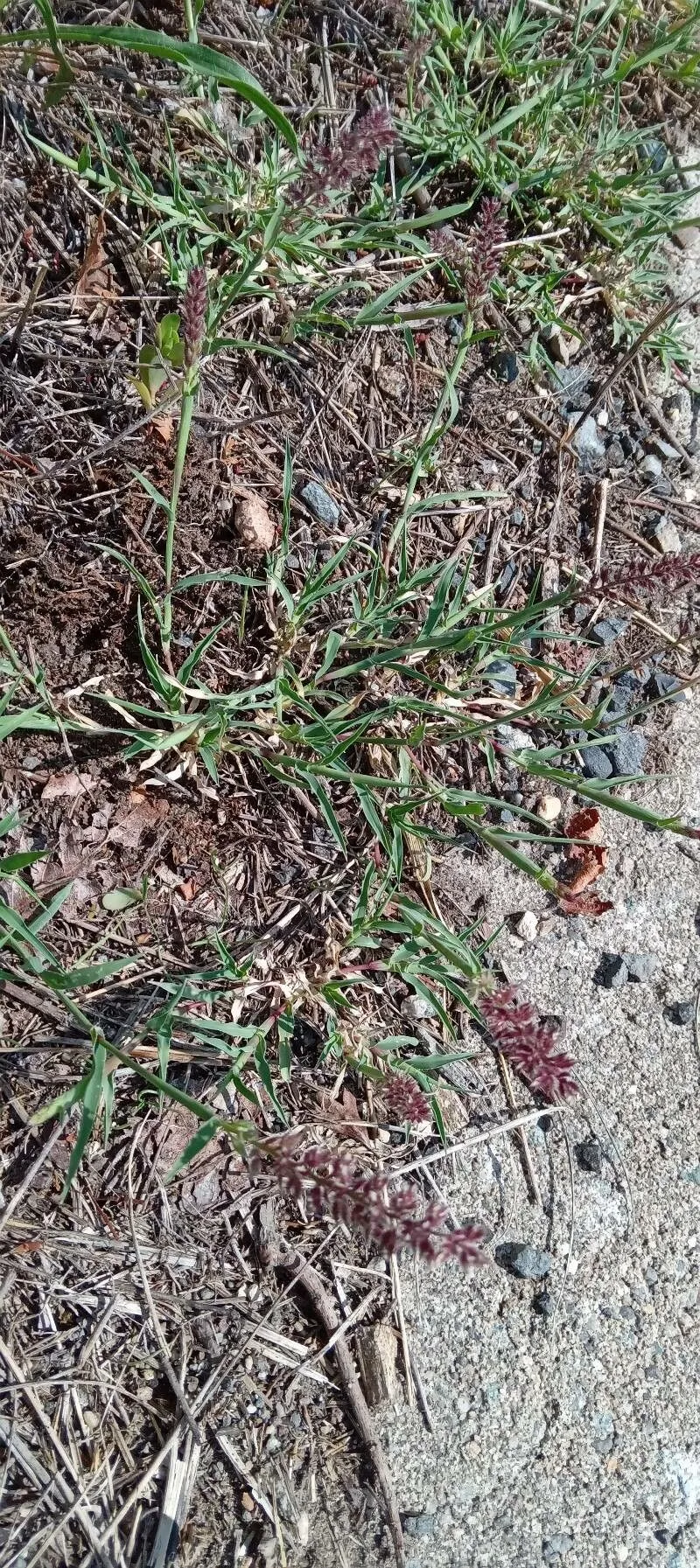
Author: (L.) All.
Bibliography: Fl. Pedem. 2: 241 (1785)
Year: 1785
Status: accepted
Rank: species
Genus: Tragus
Vegetable: False
Observations: Europe to C. Asia and Pakistan, Trop. & S. Africa to Arabian Pen.
The European bur grass, scientifically known as Tragus racemosus, is a noteworthy member of the Poaceae family. First described in the literature in the year 1785, as detailed in Fl. Pedem. 2: 241, this resilient species has managed to spread its presence significantly across various parts of the globe.
Originally indigenous to Europe, Tragus racemosus has expanded its territory to Central Asia and Pakistan. This species has also made its mark in Tropical and Southern Africa, making its way to the Arabian Peninsula, thereby showcasing its adaptability to varied climatic conditions.
Characterized by its distinctive bur-like clusters, European bur grass thrives in a range of habitats. It is recognized for its remarkable ability to grow in both temperate and tropical climates, highlighting its resilient nature. This versatility may be one of the reasons behind its widespread distribution across different continents.
Cultural and Ecological Impact
The presence of Tragus racemosus in diverse geographical regions hints at its potential impact on local ecosystems. Like many grasses in the Poaceae family, the European bur grass may play a significant role in soil stabilization, providing ground cover that helps prevent soil erosion. Additionally, its ubiquity means it can be a source of sustenance for various herbivores in these regions, thus integrating into the local food webs.
Scientific Studies and Observations
Numerous studies have observed the spread and adaptability of Tragus racemosus. These observations are crucial for understanding its ecological impact, especially in non-native regions where it may exhibit invasive tendencies. Research continues to monitor its growth patterns, reproductive mechanisms, and interactions with other flora and fauna.
Given its extensive range, European bur grass serves as an intriguing subject for botanists and ecologists alike. Its spread from Europe to the diverse climates of Central Asia, Pakistan, Africa, and the Arabian Peninsula is a testament to the species’ resilience and adaptability.
In conclusion, the European bur grass, Tragus racemosus, is an impressive species that has carved out a niche for itself in a variety of ecosystems far beyond its native habitat. Its introduction and establishment in regions spanning Europe, Asia, and Africa underscore its ecological versatility and resilience. As studies continue, Tragus racemosus will undoubtedly remain a species of interest for those in the fields of botany and ecology.
Eng: european bur-grass, european bur grass, stalked bur grass, large carrot-seed grass, spike bur grass
Deu: klettengras, traubiges klettengras
Ces: bodloplev hroznatý
Swe: piprensargräs
Hun: tövisperje
Nld: klitgras
Cym: glaswellt pigog ewrop
En: European bur grass, Large carrot-seed grass, Stalked bur grass, Spike bur grass, European Bur-grass, Stalked Burgrass, Carrot seed grass, Spike Burgrass, Spiked burr grass, Spiked burrgrass
Ar: أريبى، عدار هموريت (عَدار هموريت), هروى (هَروى)
Ca: Cerretes
Cs: Bodloplev hroznatý
Nl: Klitgras
Fr: Bardanette à grappes, Bardanette en grappe, Bardanette rameuse
De: Klettengras, Traubiges Klettengras, Klettgras
Hu: Tövisperje
It: Lappola
Es: Carretes
Sv: Piprensargräs
Cy: Glaswellt Pigog Ewrop
Taken Jul 20, 2013 by Tela Botanica − Daniel CAHEN (cc-by-sa)
Taken Oct 5, 2011 by Tela Botanica − Pierre CONSTANT (cc-by-sa)
Taken Sep 27, 2014 by Tela Botanica − Geneviève Botti (cc-by-sa)
Taken Sep 4, 2022 by Fabrice Rubio (cc-by-sa)
Taken Sep 4, 2022 by Fabrice Rubio (cc-by-sa)
© copyright of the Board of Trustees of the Royal Botanic Gardens, Kew.
© copyright of the Board of Trustees of the Royal Botanic Gardens, Kew.
© copyright of the Board of Trustees of the Royal Botanic Gardens, Kew.
Taken Sep 4, 2022 by Fabrice Rubio (cc-by-sa)
Taken Oct 19, 2022 by Fabrice Rubio (cc-by-sa)
Taken Jul 31, 2022 by Fabrice Rubio (cc-by-sa)
Taken Sep 4, 2022 by Fabrice Rubio (cc-by-sa)
Taken Jul 31, 2022 by Fabrice Rubio (cc-by-sa)
Taken Oct 7, 2022 by Aman Mahla (cc-by-sa)
Taken Jul 31, 2022 by Fabrice Rubio (cc-by-sa)
Taken Aug 7, 2014 by Tela Botanica − Charles GRATIEN (cc-by-sa)
Taken Jul 31, 2022 by Fabrice Rubio (cc-by-sa)
Taken Sep 4, 2022 by Fabrice Rubio (cc-by-sa)
Taken Sep 4, 2022 by Fabrice Rubio (cc-by-sa)
Taken Jul 31, 2022 by Fabrice Rubio (cc-by-sa)
Taken Oct 19, 2022 by Fabrice Rubio (cc-by-sa)
Taken Sep 4, 2022 by Fabrice Rubio (cc-by-sa)
Taken Jul 31, 2022 by Fabrice Rubio (cc-by-sa)
Taken Sep 15, 2009 by Photoflora – Jean-Luc TASSET (©)
Taken Sep 15, 2007 by Photoflora – Jean-Luc TASSET (©)
Taken Jul 15, 2008 by Photoflora – Benoit BOCK (©)
Taken Jan 1, 1970 by Photoflora – L’Abbé COSTE (©)
Taken Jul 15, 2008 by Photoflora – Benoit BOCK (©)
Taken Sep 15, 2011 by Photoflora – Benoit BOCK (©)
Growth habit: Graminoid
Bloom months: [‘jun’, ‘jul’, ‘aug’, ‘sep’, ‘oct’]
Family: Myrtaceae Author: (F.Muell.) K.D.Hill & L.A.S.Johnson Bibliography: Telopea 6: 402 (1995) Year: 1995 Status:…
Family: Rubiaceae Author: Pierre ex A.Froehner Bibliography: Notizbl. Bot. Gart. Berlin-Dahlem 1: 237 (1897) Year:…
Family: Sapindaceae Author: Koidz. Bibliography: J. Coll. Sci. Imp. Univ. Tokyo 32(1): 38 (1911) Year:…
Family: Asteraceae Author: A.Gray Bibliography: Pacif. Railr. Rep.: 107 (1857) Year: 1857 Status: accepted Rank:…
Family: Fabaceae Author: Medik. Bibliography: Vorles. Churpfälz. Phys.-Ökon. Ges. 2: 398 (1787) Year: 1787 Status:…
Family: Aspleniaceae Author: (Cav.) Alston Bibliography: Bull. Misc. Inform. Kew 1932: 309 (1932) Year: 1932…